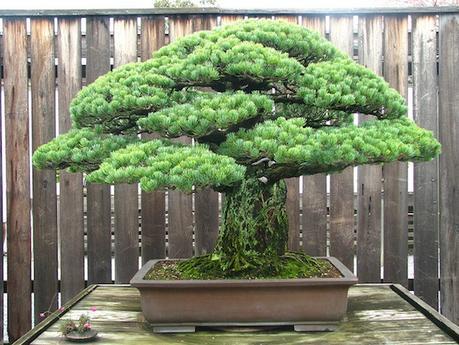I'd like to share this uplifting piece from Upworthy:
It took 25 years for anyone to figure out this bonsai tree survived the Hiroshima bombing.
This Japanese white pine tree is almost 400 years old.
It stands just a few feet tall and has carefully pruned piney branches extending from a short, mossy trunk.
It lives in the U.S. National Arboretum as part of the National Bonsai and Penjing Museum, where it's the oldest tree in the collection.
Oh, yeah, and it survived the devastating Hiroshima bombing of 1945.
At 8:15 a.m. on Aug. 6, 1945, two American pilots dropped a 9,700-pound atomic bomb over the Japanese city of Hiroshima. Within minutes, the entire city had been leveled. Some accounts say everything within a four-mile radius of the initial blast was incinerated almost instantly.
Except, it seems, for this now-390-year-old Japanese pine tree, which miraculously survived despite being just over two miles away from the center of the blast.
In 1976, the National Arboretum in Washington, D.C., received the tree from Japanese bonsai master Masaru Yamaki in celebration of the American bicentennial.
It wasn't until 2001, 25 years later, when Yamaki's grandsons came to visit the tree in person, that officials learned of its amazing journey.
Read the rest here - it's fascinating.
And continuing with the hey-it's-Friday fun botanical theme, in a totally different direction, from Raw Story :
Was Shakespeare high when he wrote his plays?
State-of-the-art forensic technology from South Africa has been used to try and unravel the mystery of what was smoked in tobacco pipes found in the Stratford-upon-Avon garden of British playwright William Shakespeare.
Residue from clay tobacco pipes more than 400 years old from the playwright’s garden were analysed in Pretoria using a sophisticated technique called gas chromatography mass spectrometry.
ADVERTISEMENT Chemicals from pipe bowls and stems which had been excavated from Shakespeare’ garden and adjacent areas were identified and quantified during the forensic study. The artefacts for the study were on loan from the Shakespeare Birthplace Trust.
The gas technique is very sensitive to residues that can be preserved in pipes even if they had been smoked 400 years ago.
What were they smoking
There were several kinds of tobacco in the 17th century, including the North American Nicotiana (from which we get nicotine), and cocaine (Erythroxylum), which is obtained from Peruvian coca leaves.
It has been claimed that Sir Francis Drake may have brought coca leaves to England after his visit to Peru, just as Sir Walter Raleigh had brought “tobacco leaves” (Nicotiana) from Virginia in North America.
In a recent issue of a magazine called Country Life, Mark Griffiths has stimulated great interest in John Gerard’s Herbal, published in 1597 as a botanical book which includes engraved images of several people in the frontispiece. One of them (cited as “The Fourth Man”) is identified by Griffiths as William Shakespeare, but this identification is questionable.
Possibly, the engraving represents Sir Francis Drake, who knew Gerard.
Gerard’s Herbal refers to various kinds of “tobacco” introduced to Europe by Drake and Raleigh in the days of Shakespeare in Elizabethan England.
There certainly is a link between Drake and plants from the New World, notably corn, the potato and “tobacco”. Furthermore, one can associate Raleigh with the introduction of “tobacco” to Europe from North America (notably in the context of the tobacco plant called Nicotiana, from Virginia and elsewhere).
What we found
There was unquestionable evidence for the smoking of coca leaves in early 17th century England, based on chemical evidence from two pipes in the Stratford-upon-Avon area.
Neither of the pipes with cocaine came from Shakepeare’s garden. But four of the pipes with cannabis did.
Results of this study (including 24 pipe fragments) indicated cannabis in eight samples, nicotine in at least one sample, and in two samples definite evidence for Peruvian cocaine from coca leaves.
Shakespeare may have been aware of the deleterious effects of cocaine as a strange compound. Possibly, he preferred cannabis as a weed with mind-stimulating properties.
You can read the rest here. Personally simply finding pipes with this residue lacks the rigorous provenance that is necessary to assert that Shakespeare owned or used these pipes, as distinct from someone else, much less that at the time he wrote he was under any influence or inspiration than what was naturally occurring inside his head. But this certainly does shed some interesting lights on what was customary back in ye olde 16th century.

